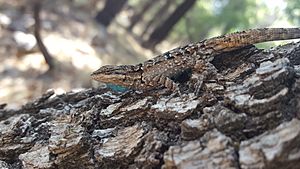Ornate tree lizard facts for kids
Quick facts for kids Urosaurus ornatus |
|
|---|---|
 |
|
| Conservation status | |
| Scientific classification | |
| Genus: |
Urosaurus
|
| Species: |
ornatus
|
| Synonyms | |
|
|
The Urosaurus ornatus, also known as the ornate tree lizard, is a type of lizard found in the southwestern United States and northwestern Mexico. These lizards are part of the Phrynosomatidae family. Scientists have studied them to learn how animals react to stress and competition. They also look at how their lives change when they have babies. A cool fact about these lizards is that male ornate tree lizards can have different throat colors. These colors can even show how they behave and what their plans are for having babies!
Contents
What Ornate Tree Lizards Eat
Ornate tree lizards mostly eat insects. They also enjoy eating insect larvae, which are like baby insects.
Reproduction and Life Cycle
Ornate tree lizards usually live in groups. A group often has one male and one or more females. They like to live near large trees, bushes, or big rocks. After a male and female mate, the female carries the eggs inside her body for about two weeks. In many places where they live, female lizards can lay more than one group of eggs each year.
Males often protect their living areas, called territories. They do this by being aggressive towards other males. This aggressive behavior can become stronger if they have higher levels of certain hormones, like testosterone. Females also have areas where they live, but they do not usually defend them. If there are fewer females in a male's territory, the male might leave that area.
Female lizards can also have different throat colors, but this is not as well-studied. When a female is carrying eggs, her throat often looks orange or red. Some studies suggest that females might prefer to mate with certain types of males based on their throat color. This choice can also depend on the female's own throat color.
Appearance and Throat Colors
The ornate tree lizard can grow to be about 59 millimeters (2.3 inches) long, not counting its tail. Adult males have two blue patches of skin on their bellies. Females do not have these blue patches.
Male ornate tree lizards come in many different colors. While not all groups of lizards have every color, scientists have found 9 different color types in U. ornatus. For example, in Verde River, Arizona, there are two main color patterns for males. One type has a blue spot in the middle of a larger orange patch on their throat, which is called a "dewlap." The other type has a solid orange dewlap.
Males with orange and blue throats are usually more aggressive. They defend territories that can include up to four females. Males with solid orange throats are often thinner and less aggressive. Orange males might move around a lot during dry years. During rainy years, they tend to stay in smaller territories.
Scientists think that the levels of certain hormones in a male lizard's blood when it is young can affect its throat color. For example, high levels of progesterone and then testosterone might lead to an orange-blue throat. Lower levels might lead to an orange throat. During dry weather, orange-type males might have more of a hormone called corticosterone. This can make their testosterone levels drop, causing them to leave their territory and become nomadic. Orange-blue males do not react this way to the weather and usually stay in their territories.
Types of Ornate Tree Lizards
Scientists recognize ten different types, or subspecies, of the ornate tree lizard. These include:
- U. o. ornatus (Baird & Girard, 1852) – known as the Texas tree lizard
- U. o. caeruleus (H.M. Smith, 1935)
- U. o. chiricahuae (Mittleman, 1941)
- U. o. lateralis (Boulenger, 1883)
- U. o. levis (Stejneger, 1890) – known as the smooth tree lizard
- U. o. linearis (Baird, 1859) – known as the lined tree lizard
- U. o. schmidti (Mittleman, 1940) – known as the Big Bend tree lizard
- U. o. schottii (Baird, 1858) – Schott's tree lizard
- U. o. symmetricus (Baird, 1858) – known as the Colorado River tree lizard
- U. o. wrighti (Schmidt, 1921) – known as the northern tree lizard
If you see a name in parentheses after the subspecies name, it means that type was first described under a different genus name.
Naming the Subspecies
Some subspecies are named after important scientists:
- The name schmidti honors an American reptile expert named Karl P. Schmidt.
- The name schottii honors a German-American naturalist named Arthur Carl Victor Schott.
- The name wrighti honors an American reptile expert named Albert Hazen Wright.
Where Ornate Tree Lizards Live
These lizards can be found in many parts of the United States, including California, Nevada, Utah, Colorado, Wyoming, Arizona, New Mexico, and Texas.
They also live in parts of Mexico, specifically in the states of Sonora, Sinaloa, Chihuahua, and Coahuila.
See also
 In Spanish: Urosaurus ornatus para niños
In Spanish: Urosaurus ornatus para niños


